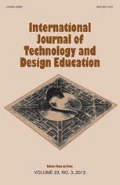Abstract
This paper discusses the Archimath programme, which was designed to develop awareness of the built environment in elementary school students, and to initiate an effort to improve it. Acknowledging the relationship between education and awareness of the environment, the programme was constructed for use with elementary school students selected from fourth to eighth grades, as an integrated mathematics and architecture programme. It includes topics from an introductory course for architecture majors and from the elementary mathematics curriculum. The programme was implemented in several pilot schools in Istanbul and was evaluated in accordance with activity sheets, pre- and post-perception tests, and the views and comments of the teachers who carried out the programme. It was revised and reorganized in accordance with this feedback and then implemented again on different groups of students in the selected schools. This paper discusses how the programme was conceived and developed.



Similar content being viewed by others
References
Anderson, J. (1999). Being mathematically educated in the 21st century: What should it mean. In C. Hoylrs, C. Morgan, & G. Woodhouse (Eds.), Rethinking the mathematics curriculum (pp. 8–21). London: The Palmer Press.
Bowler-Reyer, A. (1999). Becoming a woman in the 1970s: Female adolescent sexual identity and popular literature. In S. R. Mazzarella & N. O. Pecora (Eds.), Growing up girls: Popular culture and construction identity (pp. 21–48). New York: Peter Lang.
Burnet, S., & Lane, D. (1980). Effects of academic instruction on spatial visualization. Intelligence, 4, 233–242.
Ching, F. (1996). Architecture: Form space and order. New York: Wiley.
Clemens, D., & Battista, M. (1992). Geometry and spatial reasoning. In D. A. Grouws (Ed.), Handbook of research on mathematics teaching and learning (pp. 420–464). New York: Macmillan.
De Bono, E. (2004). Thinking course: Powerful tools to transform your thinking. London: BBC Books.
Elam, K. (2001). Geometry of design: Studies on proportion and composition. New York: Princeton Architectural Press.
Elliot, J., & Smith, I. (1983). An international dictionary of spatial tests. Winstor: Nelson Publishing Company.
Erktin, E., & Soygenis, S. (2004). The relationship of mathematics and architecture in the process of the integration of artificial environment training to primary education curriculum. Unpublished research report submitted to The Scientific and Technological Research Council of Turkey.
Ethington, C. (1992). Gender differences in a psychological model of mathematics achievement. Journal for Research in Mathematics Education, 23(2), 166–181.
Holl, S. (1991). Anchoring. New York: Princeton Architectural Press.
Hollingworth, H., Lokan, J., & McRae, B. (2003). Teaching mathematics in Australia: Results from the TIMMSS 1999 video study. Melbourne, Victoria: Australian Council for Educational Research.
Le Corbusier. (1986). Towards a new architecture (F. Etchells, Trans.). New York: Dover Publications.
Lougland, T., Reid, A., & Petocz, P. (2002). Young people’s conceptions of environment: A phenomenographic analysis. Environmental Education Research, 8(2), 187–197.
Lundström, M., & Nordström, M. (Eds.). (2001). The city at their Fingertips-Current, projects with children and young people in Sweden. Sweden: The Swedish Urban Environment Council Publications.
Markku, S. (2002). Attitude towards mathematics: Emotions, expectations and values. Educational Studies in Mathematics, 49(1), 67–81.
Mc Gee, M. (1979). Human spatial abilities: Sources of sex differences. New York: Praeger.
Mellas, L. (2003). Children designing the future. http://www.nexus.edu.au/teachstud/gat/giezwal.htm. Accessed 15 Nov 2003.
Moore, G. T., Tuttle, D. P., & Howell, S. C. (1985). Environmental design research directions: Process and prospect. New York: Praeger Publishers.
Murphy, P. F., & Gibbs, C. V. (1996). Equity in the classroom: Towards effective pedagogy for girls and boys. London: The Palmer Press.
National council of teachers of mathematics (NCTM). (1989). Curriculum and evaluation standards for school mathematics. Reston: The Council.
Norby, R. (2003). It is gender issue: Changes in attitudes towards science in a technology based K-8 pre-service preparation science classroom. Philadelphia: Annual Meeting of the National Association for Research in Science Teaching.
Olkun, S. (2003). Making connections: Improving spatial ability with engineering drawing abilities. International Journal of Mathematics Teaching and Learning, (April, 17). [Online]: 1- http://www.ex.ac.uk/cimt/ilmt/ijabout.htm. Accessed 10 Oct 2008.
Pellegrino, J., Alderton, D., & Shute, V. (1984). Understanding spatial ability. Educational Psychologist, 19(4), 239–253.
Roorda, J. (1994). Visual perception, spatial visualization and engineering drawing. Engineering Design Graphics Journal, 58, 12–21.
Roth, L. (1993). Understanding architecture: Its elements, history, and meaning. New York: Icon Editions.
Salingaros, N. (1999). Architecture, patterns and mathematics. Nexus Network Journal, 1, 75–86.
Shepardson, D. (2005). Student ideas: What is an environment? The Journal of Environmental Education, 36(4), 49–58.
Soygenis, S. (2006). Mimarlik dusunmek duslemek (Thinking imagining architecture). Istanbul: Yapi Endustri Merkezi.
Stepulevage, L. (2001). Gender/technology relations: Complicating the gender binary. Gender and Education, 13(3), 325–338.
Stylianou, D. A., & Grzegorczyk, I. (2005). Symmetry in mathematics and art: Exploration of an art venue for the learning of mathematics. Primus, 15(1), 30–44.
Taylor, A. (1993). How schools are redesigning their space. Educational Leadership, 5(1), 36–41.
Van de Walle, J. A. (2001). Elementary and middle school mathematics: Teaching developmentally. New York: Addison Wesley Longman.
Vaughan, C., Gack, J., Solorazano, H., & Ray, R. (2003). The effect of environmental education on schoolchildren, their parents and community members: A study of intergeneration and intercommunity learning. The Journal of Environmental Education, 34(3), 12–21.
Vitruvius, P. (1960). The ten books on architecture. (M. H. Morgan, Trans.). New York: Dover Publications.
Watt, H. (2005). Exploring adolescent motivations for pursuing maths-related careers. Australian Journal of Educational and Developmental Psychology, 5, 107–116.
Wigfield, A., & Eccles, J. (2000). Expectancy-value theory of achievement motivation. Contemporary Educational Psychology, 25, 68–81.
Author information
Authors and Affiliations
Corresponding author
Rights and permissions
About this article
Cite this article
Soygenis, S., Erktin, E. Juxtaposition of architecture and mathematics for elementary school students. Int J Technol Des Educ 20, 403–415 (2010). https://doi.org/10.1007/s10798-009-9100-1
Published:
Issue Date:
DOI: https://doi.org/10.1007/s10798-009-9100-1




